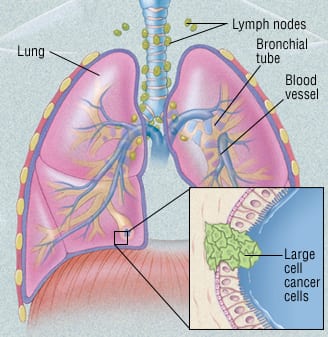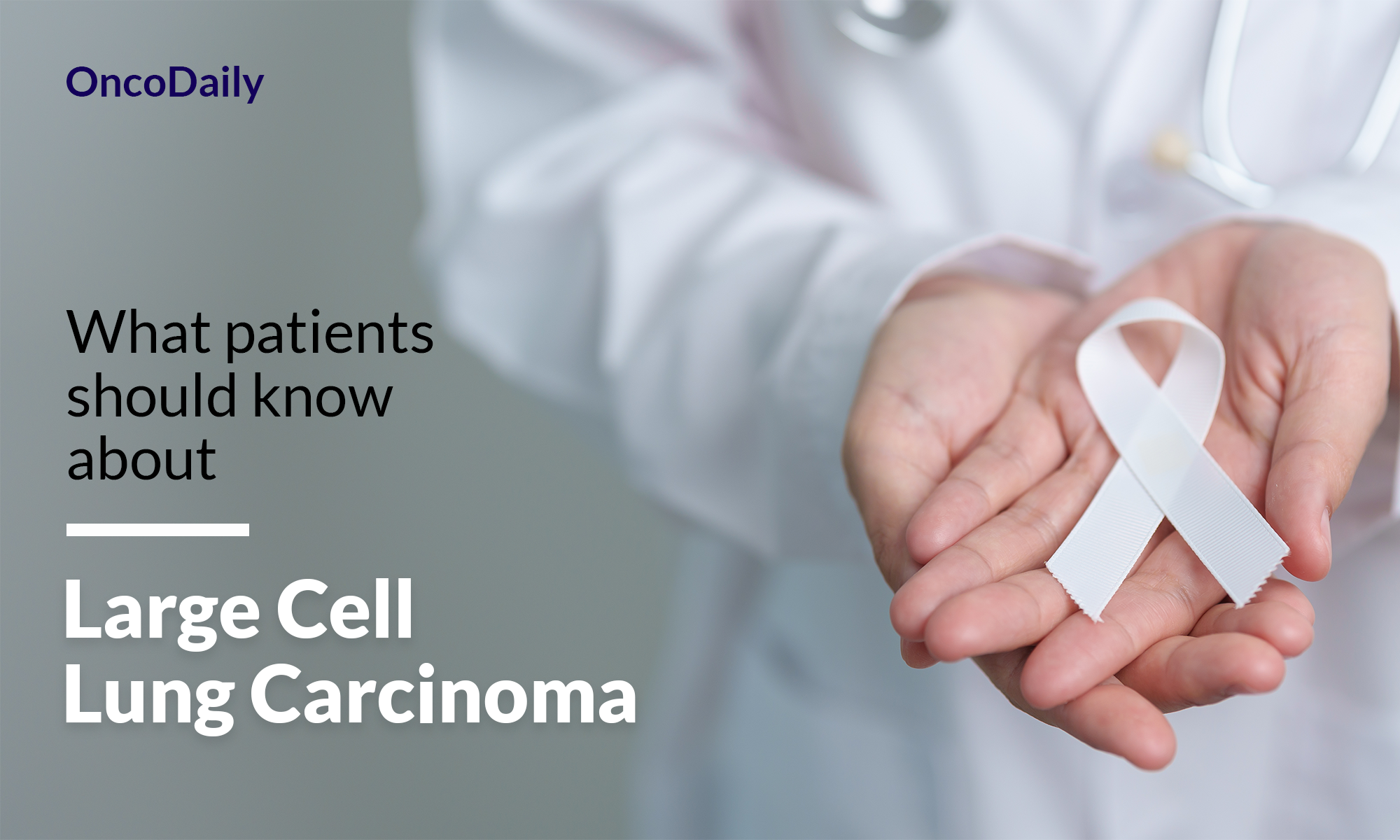What is Large Cell Lung Carcinoma
Large cell lung carcinoma (LCLC) is a rare and aggressive type of non-small cell lung cancer (NSCLC) that accounts for 10-15% of all NSCLC cases. It is characterized by large, undifferentiated cells that lack the features of other NSCLC subtypes like lung adenocarcinoma or squamous cell carcinoma.

Source of image 2minutemedicine.com
Causes and Risk Factors
Causes and Risk Factors of large cell lung carcinoma include various factors that can increase the likelihood of developing this type of lung cancer. Here are the key points based on the provided sources:
- Smoking: Smoking is the primary risk factor for lung cancer, including large cell carcinoma. About 80% of lung cancer deaths are attributed to smoking, making it a significant risk factor.
- Secondhand Smoke: Exposure to secondhand smoke or environmental tobacco smoke can also increase the risk of developing lung cancer, including large cell carcinoma. Secondhand smoke is the third most common cause of lung cancer in the United States.
- Radon Exposure: Radon, a naturally occurring radioactive gas found in soil and rocks, is the second-leading cause of lung cancer in the United States. Breathing in radon, especially in indoor environments with high concentrations, can elevate the risk of developing lung cancer, including large cell carcinoma.
- Occupational Exposure: Workplace exposure to carcinogens like asbestos, arsenic, chromium, and nickel can increase the risk of developing lung cancer, particularly in combination with smoking. Individuals with prolonged exposure to these substances are at a higher risk of developing large-cell carcinoma.
- Family History: A personal or family history of lung cancer can also contribute to an increased risk of developing the disease. Individuals with a family history of lung cancer, especially if diagnosed at a younger age, may have a slightly higher risk of developing large cell carcinoma.
- Previous Radiation Therapy: People who have undergone radiation therapy to the chest for other cancers, particularly if they smoke, are at a higher risk of developing lung cancer, including large cell carcinoma. Examples include individuals treated for Hodgkin lymphoma or breast cancer with chest radiation.
These factors play a significant role in the development of large-cell lung carcinoma, highlighting the importance of risk factor awareness and lifestyle modifications to reduce the likelihood of developing this aggressive form of lung cancer.
Symptoms
The symptoms of large cell carcinoma are similar to those of other types of lung cancer and may not be apparent in the early stages of the disease. The most common symptoms include:
- Cough: A persistent cough that worsens over time
- Shortness of breath: Mild dyspnea (shortness of breath) is common
- Chest pain: Chest pain or achiness in the back, shoulder or chest
- Fever: Fever is a symptom that can occur in some cases of large cell carcinoma.
- Weight loss: Unexplained weight loss without intention
- Fatigue: Persistent fatigue or tiredness
- Night sweats: Drenching night sweats can be a symptom of large cell carcinoma, particularly in cases where cancer has spread
- Difficulty swallowing: Trouble swallowing can be a symptom of large cell carcinoma, especially if the cancer has spread to the esophagus
- Swelling around the face or neck: Swelling around the face or neck can be a symptom of large cell carcinoma, particularly if the cancer has spread to the lymph nodes in these areas
Timing and Progression of Symptoms
- Early symptoms are often non-specific and can be easily attributed to other less serious conditions.
- Symptoms tend to worsen and become more severe as the cancer progresses.
- Symptoms may be absent in the early stages, leading to delayed diagnosis in many cases.
Importance of Seeking Medical Attention
- Seek immediate medical care for severe symptoms like coughing up blood, severe shortness of breath, chest pain, difficulty swallowing, or facial/neck swelling.
- Early diagnosis is crucial, as it allows for more treatment options and potentially better outcomes.
In summary, the symptoms of large cell lung carcinoma are often non-specific in the early stages but can progress to include cough, shortness of breath, chest pain, fatigue, weight loss, fever, and night sweats. Prompt medical attention is important, especially for severe or worsening symptoms.
Diagnosis
Imaging Tests
The diagnostic process usually begins with imaging tests like chest X-rays or CT scans to detect abnormalities or tumors in the lungs. These imaging tests can help locate the tumor and determine if it has spread to other areas of the body.
Biopsy
A definitive diagnosis of large cell lung carcinoma requires a biopsy, which involves taking a sample of the lung tissue or cells for examination under a microscope. This can be done through various procedures such as:
- Bronchoscopy: A flexible tube is inserted through the mouth or nose into the lungs to collect cell samples.
- Needle biopsy: A hollow needle is inserted through the chest wall to extract a tissue sample from the lung tumor.
- Surgical biopsy: A portion of the lung is surgically removed for examination.
Pathological Examination
The biopsy sample is then examined under a microscope by a pathologist to determine the specific type of lung cancer. Large cell lung carcinoma is diagnosed when the cancer cells appear large and undifferentiated, lacking the characteristics of other NSCLC subtypes like adenocarcinoma or squamous cell carcinoma.
In summary, the diagnosis of large cell lung carcinoma involves a combination of diagnostic methods, including biopsy procedures, pathological examination, and immunohistochemical staining to accurately identify and characterize the cancer. Prompt and accurate diagnosis is crucial for determining appropriate treatment strategies and improving patient outcomes.
Treatment
The main treatment options for large cell lung carcinoma (LCLC) depend on the stage of the cancer and whether it can be surgically removed:
Surgery
- Surgery is the most effective treatment for early-stage large-cell lung carcinoma (stages I-III). Options include wedge resection, lobectomy, or pneumonectomy to remove the tumor and surrounding lung tissue.
- Surgery alone may be sufficient for very early-stage IA disease. However, studies suggest adjuvant chemotherapy after surgery improves overall survival for stage IB and higher.
Chemotherapy
- Chemotherapy is commonly used in combination with surgery for early-stage large-cell lung carcinoma, or as the primary treatment for advanced-stage III/IV disease that cannot be surgically removed.
- Platinum-based chemotherapy regimens like cisplatin/etoposide or cisplatin/irinotecan are commonly used.
- A large SEER database study found chemotherapy improved overall survival and cancer-specific survival compared to no chemotherapy for stage II-IV large cell lung carcinoma patients.
Radiation Therapy
- Radiation therapy may be used in combination with chemotherapy as the primary treatment for unresectable stage III large cell lung carcinoma.
- Radiation can also be used after surgery to kill any remaining cancer cells.
Targeted Therapy and Immunotherapy
- Targeted therapies and immunotherapies are newer treatment options being explored for large-cell lung carcinoma, but their role is still being defined.
- Biomarker testing is important to identify potential targets for these therapies.
In summary, surgery is the mainstay of treatment for early stage large cell lung carcinoma, often combined with adjuvant chemotherapy. Chemotherapy and radiation are the primary treatments for advanced, unresectable diseases. Newer targeted and immune-based therapies are also being investigated for LCLC.
Prognosis and Survivorship
The prognosis and survivorship of large cell lung carcinoma are influenced by factors such as stage, treatment modalities like surgery, chemotherapy, and targeted therapy, as well as histologic subtypes. Understanding these factors is crucial in determining the most effective treatment strategies and predicting outcomes for patients with large-cell lung carcinoma.
Surgery can significantly improve survival rates, even in advanced stages. The overall survival for large cell lung carcinoma patients varies, with some living for months to years after diagnosis. While the journey may be tough, staying informed, discussing treatment options with your healthcare team, and seeking support from loved ones can make a significant difference. Remember, each person’s experience is unique, and advancements in treatment are continually being made to improve outcomes for large-cell lung carcinoma patients.
Watch Desiree’s fight story from Amgen.
Survivorship Challenges
Physical symptoms: Survivors may experience ongoing respiratory issues, fatigue, hearing loss, neuropathy, and post-surgical pain. These physical side effects can significantly impact quality of life.
Psychological distress: Many survivors struggle with depression, anxiety, and fear of cancer recurrence. Addressing the mental health needs of lung cancer survivors is crucial.
Financial toxicity: The high costs of cancer treatment can lead to financial instability and hardship for survivors. This is an under-recognized problem that requires more attention.
Stigma: Lung cancer survivors may face stigma due to the association with smoking, which can further exacerbate emotional and social challenges.
Lack of survivorship care: There is a need for better coordination between oncology and primary care providers to ensure comprehensive survivorship care, including surveillance, management of long-term effects, and health promotion.
In summary, lung cancer survivors face a complex array of physical, psychological, and socioeconomic challenges that require a multidisciplinary approach to address their diverse needs and improve their overall quality of life.
During Treatment
Common side effects include
During treatment for large cell lung carcinoma (LCLC), patients may experience several common side effects:
Surgery
- Respiratory issues
- Postsurgical pain
Radiation Therapy
- Fatigue
- Skin changes like redness and dryness
- Difficulty swallowing
- Cough and shortness of breath (chronic radiation pneumonitis in about 4% of patients)
Chemotherapy
- Fatigue
- Hair loss
- Nausea and vomiting
- Increased risk of infection due to low white blood cell counts (neutropenia)
- Anemia (low red blood cell counts)
- Easy bruising and bleeding
Targeted Therapies and Immunotherapies
- Side effects vary depending on the specific drug, but tend to be less severe than chemotherapy
- Other general side effects that may occur with any treatment include:
- Loss of appetite
- Weight loss
- Shortness of breath
- Cough
- Chest pain
It’s important for large cell lung carcinoma patients to report any side effects to their healthcare team, as many can be managed with supportive care. Maintaining good nutrition and staying active can also help manage side effects and maintain quality of life during treatment.
After Treatment
Follow-up Care
- Regular follow-up visits with healthcare providers are crucial for the early detection of cancer recurrence or new lung cancers.
- For early-stage (stage I-II) non-small cell lung cancer (which includes large cell carcinoma), the recommended follow-up is a physical exam and chest CT scan every 6 months for the first 2-3 years, then annually.
- For advanced-stage (stage III-IV) non-small cell lung cancer, follow-up should be more frequent – a physical exam and chest CT every 3-6 months for the first 3 years, then every 6 months for 2 more years, and then annually.
- In addition to monitoring for cancer recurrence, follow-up care should address management of any ongoing physical or psychological side effects from treatment.
- Survivors should also receive recommended cancer screenings, vaccinations, and guidance on healthy lifestyle behaviors to promote overall health.
- Close coordination between oncology and primary care providers is important to ensure comprehensive survivorship care.
- The specific follow-up schedule may be adjusted based on individual risk factors for recurrence.
In summary, regular, guideline-based follow-up care is crucial for large-cell lung carcinoma survivors to detect recurrence early, manage long-term effects, and promote overall health and well-being.
Resources
- American Cancer Society – Cancer.org
- National Cancer Institute – Cancer.gov
- American Society of Clinical Oncology (ASCO) – Cancer.net
- Science Direct – Sciencedirect.com
- Clinical characteristics and treatments of large cell lung carcinoma: a retrospective study using SEER data – PubMed
- An Update on Survivorship Issues in Lung Cancer Patients – PubMed
- Radiopaedia -Radiopaedia.org
- Cancer Research Institute – cancerresearch.org
- City of Hope – cancercenter.com
- Oncodaily.com
